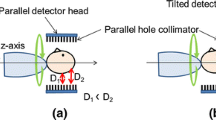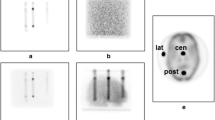Abstract
Objective
Cerebral SPECT images require high spatial and contrast resolution for precise evaluation of the abnormal tracer distribution in the brain. A shorter data acquisition time is preferable so that artifacts due to patient movement are avoided. We tried to shorten data acquisition time applying larger sampling angle and offset acquisition method, in which half degree of the step angle was shifted in the opposite gamma camera of the dual-detector SPECT system.
Methods
A simulation study was performed with a 3-dimensional mathematical phantom. The phantom studies were performed with a hot-rod phantom and a brain phantom. A clinical study with 99mTc-ECD SPECT was also performed on a patient who had a cerebral infarction. Reconstruction of images was done for the normal 6° and 12° onset and 12° offset. Data for the 12° offset were acquired by shifting of sampling angles of the opposite detector by half (6°) of the sampling angles of 12°. The MLEM algorithm was used for image reconstruction. Image qualities in the simulation study, the phantom studies, and the clinical study were compared for the 6° and 12° onset, and for the 12° offset by quantitative analysis with use of profile curves.
Results
Analysis of the profile curves revealed that the image quality of the 12° offset was better than that of the 12° onset and compared to that of the 6° onset in the simulation study, the phantom studies, and the clinical study.
Conclusions
The present study indicates that wide-angle offset data acquisition improves the image resolution of brain SPECT compared to onset data acquisition with the same sampling time.








Similar content being viewed by others
References
Takahashi Y, Murase K, Higashino H, Mochizuki T, Motomura N. SPECT imaging with off-set detector system: comparison among sampling angles 2, 4, and 6 degrees. Ann Nucl Med. 2002;16:363–7.
Sheep LA, Vardi Y. Maximum likelihood reconstruction for emission tomography. IEEE Trans Med Imag. 1982;MI-1:113–22.
Murase K, Tanada S, Inoue T, Sugawara T, Hamamoto K. Improvement of brain single photon emission tomography (SPET) using transmission data acquisition in a four-head SPET scanner. Eur J Nucl Med. 1993;20:32–8.
Motomura N, Onishi H, Shirakawa S, Takahashi M, Yanagisawa M. Research report: development of a digital phantom for nuclear medicine. Jpn J Radiol Technol. 2007;63:1313–9. (in Japanese).
Onishi H, Motomura N, Takahashi M, Yanagisawa M, Ogawa K. A 3-dimensional mathematic cylinder phantom for the evaluation of the fundamental performance of SPECT. J Nucl Med Technol. 2010;38:42–8.
Yamaki N, Natsume T, Takeda K, Maeda H, Hasabe S, Kinda A, et al. Simultaneous spatial resolution correction in SPECT reconstruction using OS-EM algorithm. Jpn J Med Phys. 2004;24:61–71. (in Japanese).
Ogawa K. Image reconstruction by ordered subsets expectation maximization method. Jpn J Med Phys. 1999;19:184–92. (in Japanese).
Asao K, Takeda H, Takaki A, Kawakami K, Teraoka S. Evaluation of the OS-EM parameter with automatic quantitative analysis for cerebral blood flow of the ECD tool. Jpn J Radiol Technol. 2008;64:822–31. (in Japanese).
Shinohara H, Yamamoto T, Sugimoto H, Hashimoto T, Takahashi M, Yokoi T. Scatter, attenuation and detector response correction of SPECT. Med Imag Tech. 2000;18:24–32. (in Japanese).
Takahashi Y, Murase K, Mochizuki T, Higashino H, Sugawara Y, Kinda A. Evaluation of the number of SPECT projections in the ordered subsets-expectation maximization image reconstruction method. Ann Nucl Med. 2003;17:525–30.
Tanaka E, Kudo H. Subset-dependent relaxation in block-iterative algorithms for image reconstruction in emission tomography. Phys Med Biol. 2003;48:1405–22.
Kanetaka H, Matsuda H, Asada T, Ohnishi T, Yamashita F, Imabayashi E, et al. Effects of partial volume correction on discrimination between very early Alzheimer’s dementia and controls using brain perfusion SPECT. Eur J Nucl Med Mol Imaging. 2004;31:975–80.
Acknowledgments
We thank Mr Akiyoshi Kinda (Toshiba Medical Systems Co., Ltd.), Ms Kyoko Saito, Mr Yoshihisa Nishimura, and Ms Mika Takahashi (Gunma Prefectural College of Health Sciences) for technical support.
Author information
Authors and Affiliations
Corresponding author
Rights and permissions
About this article
Cite this article
Takahashi, Y., Oriuchi, N., Higashino, H. et al. Improvement of image resolution of brain SPECT by use of the wide-angle offset acquisition method. Ann Nucl Med 25, 69–74 (2011). https://doi.org/10.1007/s12149-010-0430-6
Received:
Accepted:
Published:
Issue Date:
DOI: https://doi.org/10.1007/s12149-010-0430-6




